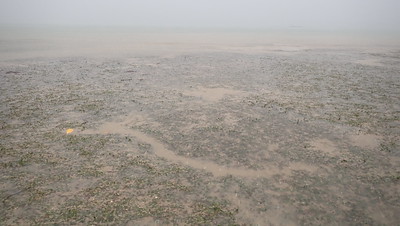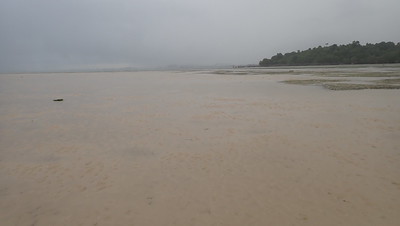It was a relief to see healthy specimens of animals that died in 2007. In fact, the team spotted special animals including Pentaceraster sea stars, our first sighting for our northern shores. We also saw signs of dugongs!
In early 2007, there was mass death on Chek Jawa following massive flooding in Johor due to heavy rain in Dec 2006. Large numbers of carpet anemones, sea cucumbers, sea stars, sponges and other marine life were found dead on Chek Jawa. Media reports and related blog posts of the 2007 event.
Today, the team saw living Common sea stars - these died out in the 2007 mass death and didn't reappear until 10 years later. Also, Pentaceraster sea star juveniles! Our first sighting for our northern shore, this sea star was first seen at Cyrene in 2008. The shorebirds were also active on the shore despite the rain. We didn't come across any that were trapped in the sand as we did in Feb 2023. |
| Montage of photos by the team. Links to their albums below. |
Today, I didn't see many animals on the northern area. This could be due to the downpour. Marine life hide from fresh water. But I did see more animals towards the southern area. But I was relieved to see healthy sea stars, sea cucumbers and even worms.
There were a few dugong trails on the seaward side of the northern sand bar. We saw many more during our last survey in Feb 2023. Dugong feeding trails are formed when dugongs chomp up seagrasses including their roots, leaving a shallow meandering furrow of about equal width and depth.
Kelvin saw a patch with many feeding trails!
Jonathan saw more feeding trails!
The northern sandbar remains vast!
Kok Sheng saw dugong feeding trail on the south sand bar too.
On the northern sand bar, there was mostly Spoon seagrass (small and large leaves) and Needle seagrass with narrow leaves.
Smooth ribbon seagrass has reached the inner lagoon. It continues to flourish and have taken over the southern sand bar and large parts of the southern area. I did see any, but others on the team saw some Fern seagrass.
What is the fate of Chek Jawa?
Chek Jawa and Pulau Sekudu is slated for reclamation in the Long-Term Plan Review. The plan includes a road link (black line) from the mainland jumping off at Punggol, crossing to Pulau Ubin through Chek Jawa to jump off to Pulau Tekong before circling back to the mainland on Changi East. Proposed reclamation (in yellow) will bury Pasir Ris shores, Pulau Sekudu and Chek Jawa as well as a large stretches of Changi Beach.
The Singapore Blue Plan 2018
Among the Proposed Areas for Immediate Conservation Priority, the Singapore Blue Plan 2018 proposes that the intertidal and subtidal marine areas of Pulau Ubin to be designated Marine Reserve.
The proposed area would include Tanjung Chek Jawa, the largest known intertidal area in northern Singapore. Considered one of the richest in Singapore, Chek Jawa comprises many adjacent ecosystems: coastal hill forest, mangrove areas, rocky shores, seagrass meadows, coral communities, and sandy areas. Chek Jawa remains an icon of celebration and hope for many Singaporeans since its reprieve from reclamation in 2001.
DOWNLOAD the Plan, SUPPORT the Plan! More on the Singapore Blue Plan 2018 site.
Posts by others on this survey
Loh Kok Sheng
Kelvin Yong
James Koh
Liz Lim
Richard Kuah
Vincent Choo
Jonathan Tan
Tommy Tan













